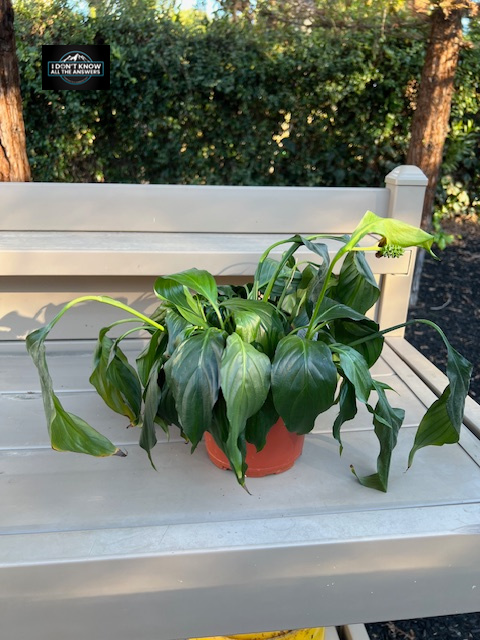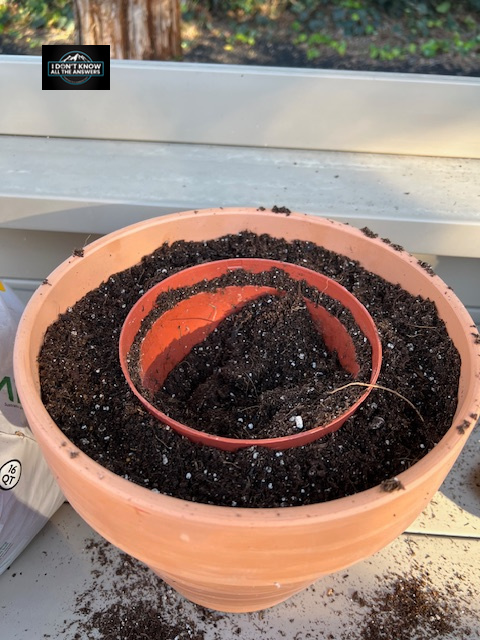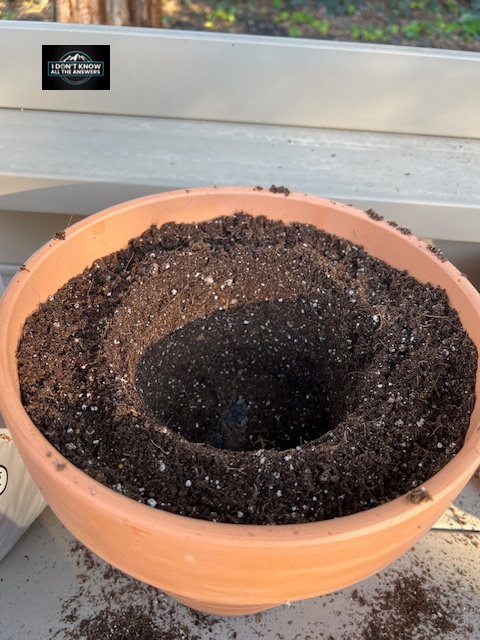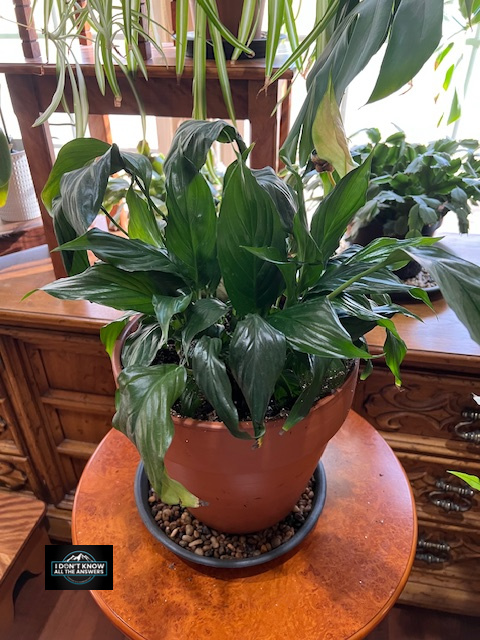I received my Peace Lily (Spathiphyllum wallisii), lovingly named Lily, as a gift from a dear friend months before our move. Lily was doing so well in the first house, and I hoped she would bring a sense of tranquility and life to my new home, but I’ll admit that she didn’t receive the attention she deserved. Between the chaos of unpacking, our never ending time consuming projects, and adjusting to a new space, Lily suffered. Her once lustrous leaves drooped in silent protest, and I could see she wasn’t thriving. But, like the resilient plant she is, after a bit of trial and error—and some heartfelt effort to repair my neglect—Lily bounced back and now graced my space with her elegant beauty. This resilience is a comforting reminder that even if we make mistakes, these plants can bounce back with a little care and attention.
You’re not alone if you’re new to peace lilies or plants. Learning their quirks and how to care for them is a process. But trust me, the effort is worth it. Here’s everything I’ve learned about keeping these beauties happy and healthy.
Why the Peace Lily is a Favorite
The Peace Lily (Spathiphyllum wallisii) is one of the most beloved indoor plants among plant enthusiasts, beginners, and indoor greenery lovers, and for a good reason. Known for its glossy dark green leaves and striking white blooms, it’s not just a gorgeous addition to your space—it’s also easy to grow and care for, making it perfect for those just starting their plant parenthood journeys. Peace lilies can purify the air, making your home healthier and fresher.
Let’s get into the nitty-gritty of caring for this graceful beauty.
Key Care Tips for a Thriving Peace Lily
1. Provide Indirect Light
Peace lilies thrive in bright, indirect light. They’ll tolerate lower light conditions, but filtered light is your best friend if you want delicate white blooms. Avoid placing them in direct sunlight, as this can scorch their leaves.
Pro tip: Position your Peace Lily near an east-facing window or where it gets soft, diffused light.
2. Master the Art of Watering
Watering can make or break your Peace Lily. They like their soil to be consistently moist but not soggy. Wait until the top inch of soil feels dry before watering, and always make sure the pot has drainage to prevent root rot.
I’ve learned this lesson the hard way. Early on, overwatering caused Lily’s leaves to turn yellow—a classic cry for help from peace lilies when their roots are waterlogged. Thankfully, cutting back on watering worked wonders.
Pro tip: Use filtered or distilled water at room temperature. Peace lilies are sensitive to chemicals like chlorine, often in tap water.
3. Maintain High Humidity
Peace lilies are native to tropical regions, so they thrive in humidity. If your home is drier, especially in winter, mist your plant regularly or place it on a pebble tray filled with water.
Note: I have pebble trays beneath all of my plants.
4. Feed for Growth
During the growing season (spring and summer), feed your peace lily with a balanced, water-soluble fertilizer once a month. Be careful not to overdo it—too much fertilizer can lead to burnt leaf tips.
Imagine it as giving your plant a little power-up so it can produce those spectacular blooms.
5. Keep Things Tidy
Dust can accumulate on peace lily leaves, making it harder for them to absorb light. To keep the leaves clean and shiny, wipe them gently with a damp cloth every few weeks.



6. Repotting is recommended Every 1-2 Years
Peace lilies like having some breathing room. If you notice your plant’s growth slowing down or roots poking out of the pot, it’s time to upsize. Repotting into a slightly larger container with fresh soil can work wonders for its health.
When I realized Lily was pot-bound and transferred her to a roomier pot, she perked up almost immediately. It was like she finally got the space she needed to thrive.
Common Peace Lily Problems and How to Fix Them
Peace lilies, while hardy, aren’t immune to issues. Here are some common problems you might encounter and how to solve them:
- Yellowing Leaves: This can indicate either overwatering or underwatering. Check the soil’s moisture level and adjust your watering routine accordingly.
- Browning Tips: Browning is often caused by too much direct sunlight or dry air. Move your plant to a spot with filtered light and increase humidity levels.
- Failure to Bloom: Peace lilies may refuse to bloom if they don’t get enough light or have outgrown their pot. Ensure your plant gets bright and has indirect light, and consider repotting.
- Pests: Spider mites and aphids can occasionally appear. I’ve had luck treating them with neem oil or a gentle insecticidal soap.
Responding to and addressing these signs promptly can make all the difference.
Choosing the Perfect Spot
Location matters more than you think. For peace lilies, a spot that offers moderate to bright, indirect light is ideal. Look for places like a well-lit living room corner or a bedroom windowsill that doesn’t get harsh afternoon sun. Also, aim for areas with consistent temperature and higher humidity—think away from drafty windows or heating vents. By understanding these needs, you can ensure your peace lily is in the best possible environment to thrive.
Repotting and Propagation Made Simple
Repotting:
Repotting your peace lily every 1-2 years is essential for healthy growth. Here’s a quick guide:
- Choose a pot 1-2 inches larger than the current one.
- Gently remove the lily from its pot and shake off excess soil.
- Please place it in the new pot with fresh, well-draining soil and water.
Propagation:
Want to grow more peace lilies from your existing plant? Divide it when repotting. Look for sections of the root ball with their leaves and gently separate them. Plant each division in its pot, and voilà—new plants!
Bringing Peace to Your Home
Caring for your peace lily is not just about having a beautiful plant to admire. It’s about creating a connection, learning their needs, and experiencing the joy of nurturing life. Lily’s recovery reminded me of what it means to slow down and show a little care—even when life feels chaotic. The joy of seeing her thrive again was a reward, a reminder of the simple pleasures that nature can bring into our lives. This joy is something you can experience too, as you watch your peace lily grow and flourish under your care.
If you’ve been hesitating to bring one of these lovely plants into your home, I encourage you to take the plunge. With the proper care, a peace lily will reward you with years of beauty, calm, and a peaceful presence.
Do you have a peace lily story of your own? I’d love to hear it in the comments below. Your experiences and insights are valuable; sharing them can inspire others on their peace lily journey. And if you’re ready to start your peace lily journey, trust that your plant will thrive with simple care tips like these!
References:
HOW TO GROW AND CARE FOR PEACE LILIES – shoreaquatic.com. https://www.shoreaquatic.com/blogs/news/how-to-grow-and-care-for-peace-lilies
How Much and How Often Should You Water Peace Lilies?. https://www.allaboutgardening.com/peace-lily-watering/
Calathea Medallion | Cotton & Leaf. https://www.cottonandleaf.co.uk/plantcareguides/calathea-medallion
Caring for the Satin Pothos: A Tale of Silky Leaves and Easy Growth – The Botanic Designer. https://thebotanicdesigner.com/caring-for-the-satin-pothos-a-tale-of-silky-leaves-and-easy-growth/
Peace Lily Plant Guide: Everything You Need To Know In 2023. https://homedecorish.com/2024/01/07/peace-lily-plant-guide/
How To Keep Your Sod Healthy – Hudson Ranch. https://hudsonranchsod.com/how-to-keep-your-sod-healthy/
Peace lily repotting shock (Many people struggle to keep…. https://apartmentflowers.com/peace-lily-repotting-shock/.

Thank you for reading this blog post. If you have any questions or comments, please leave them in the Comments section below.
Copyright © 2019. I Don’t Know All The Answers, Nikki Mastro.
All of my photographs and documents are Copyrighted.
No part of this website, including text, photographs, and documents, may be reproduced, stored in a retrieval system, or transmitted in any form or by any means without written permission from the copyright holder. All unauthorized use is strictly prohibited. If you choose to copy or share any information from my site, you must provide a link to the source. I appreciate your cooperation.
For further information concerning “I Don’t Know All The Answers.”
– Website and Blog: https://www.idontknowalltheanswers.com
– Facebook: https://www.facebook.com/Nikki.L.Mastro/
– Instagram: https://www.instagram.com/i_dont_know_all_the_answers/
– Linkedin: https://www.linkedin.com/in/nikki-mastro-05455a3a/
– Youtube Channel: https://www.youtube.com/@idontknowalltheanswers1954
